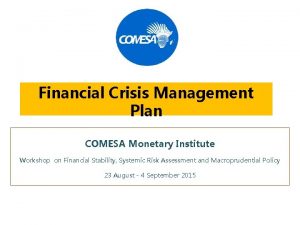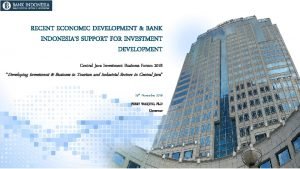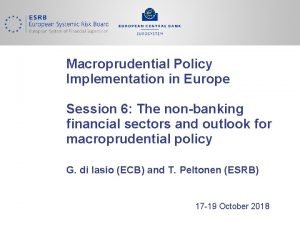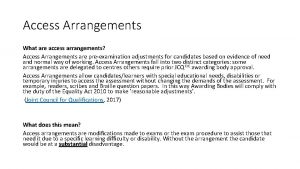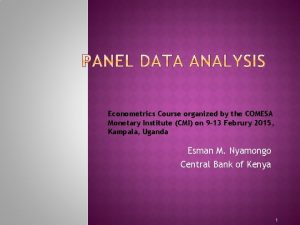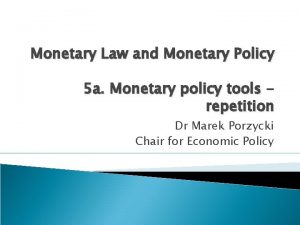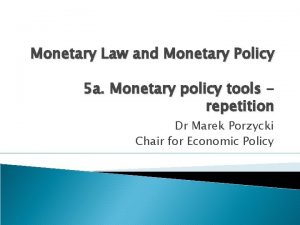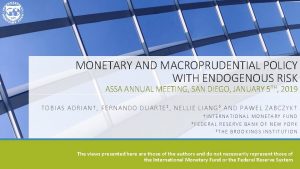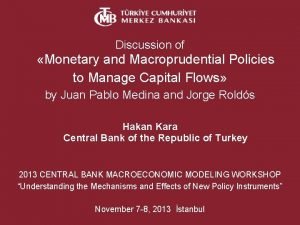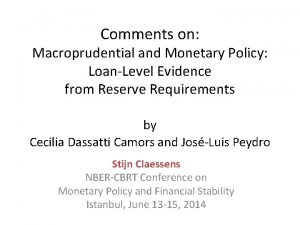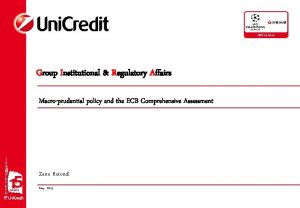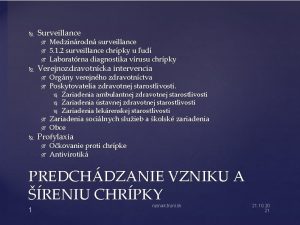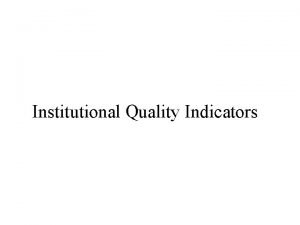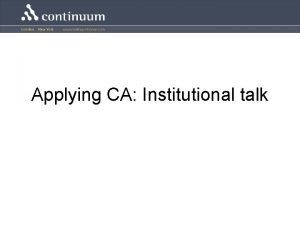Macroprudential Surveillance Institutional Arrangements Prepared for COMESA Monetary



































- Slides: 35

Macroprudential Surveillance: Institutional Arrangements Prepared for COMESA Monetary Institute 2 nd September 2015

Background • A wide range of official, academic, and private sector financial reform initiatives have surfaced in response to the recent global financial crisis. • At the regulatory architecture level: • Improved consumer protection • Refinements in the lender of last resort principles • Improvements in financial institutions’ resolution practices • Explicit systemic risk regulatory and monitoring mandate ü To be carried out either by new regulators ü Or existing regulators with a new focus. 9/2/2015 Macroprudential Surveillance: Insititutional Arrangements 2

A sound regulatory architecture Encourage innovation and efficiency, Provide transparency, Ensure safety and soundness, and Promote competitiveness in global markets Improves market discipline, reduces moral hazard arising from the “too systemic to fail” problem … • Avoids putting taxpayers at risk. • • • 9/2/2015 Macroprudential Surveillance: Insititutional Arrangements 3

A sound regulatory architecture • Avoids putting taxpayers at risk. • UK’s newly created Prudential Regulatory Authority “it is not the PRA’s role to prevent firm failure in all circumstances, to ensure that if a firm does fail it does so in an orderly manner” (PRA), Bank of England 9/2/2015 Macroprudential Surveillance: Insititutional Arrangements 4

How do we accomplish this? • Effective resolution regimes for financial institutions – New international standard for resolving banks in an orderly fashion, without exposing taxpayers (FSB Key Attributes of Effective Resolution Regimes) … in order to reduce the cost and/or impact of SIFI failures. • Mandatory resolvability assessments and Recovery and Resolution – November 2013, 29 banks identified as G-SIBs. Home and host authorities developing cooperation agreements and cross border crisis management groups. 9/2/2015 Macroprudential Surveillance: Insititutional Arrangements 5

How do we accomplish this? • Capital surcharges – Based on the “expected impact” approach, other methods – Ideally, new surcharges should be Pigouvian in design • Additional Macroeconomic Policies? • Financial Stability Councils? 9/2/2015 Macroprudential Surveillance: Insititutional Arrangements 6

Architecture Reform Proposals • Increased attention to Systemic Risk by existing Authorities. • New Systemic Risk Authorities: – European Systemic Risk Board (ESRB) – Prudential Regulatory Authority (PRA) – Financial Stability Councils 9/2/2015 Macroprudential Surveillance: Insititutional Arrangements 7

Institutional Set-up: Malaysia • A 2009 Act gave the Central Bank of Malaysia a financial stability mandate and broad powers to ensure financial stability. • The CBA vests in the Bank expanded macroprudential power and instruments to safeguard financial stability. These include wider powers … – to obtain information for purposes of monitoring risks to financial stability. – The law enables the Bank to effectively coordinate with other regulatory authorities across sectors. 9/2/2015 Macroprudential Surveillance: Insititutional Arrangements 8

Institutional Set-up: Malaysia • Governance for these powers is provided by a Financial Stability Executive Committee. It comprises: – The governor (Chair), – One deputy governor, and – Three to five other members appointed by the Treasury. 9/2/2015 Macroprudential Surveillance: Insititutional Arrangements 9

Institutional Set-up: United Kingdom • The 2010 Government Consultation Paper recommended the establishment of a new Financial Policy Committee (FPC) within the Bank of England with responsibility for macroprudential policy. – Chaired by the Governor, a substantial degree of cross-membership is envisaged with the existing Monetary Policy Committee (MPC) • The FPC is also given a set of macroprudential instruments and can make recommendations on the regulatory perimeter. 9/2/2015 Macroprudential Surveillance: Insititutional Arrangements 10

Institutional Set-up: United Kingdom • A new Prudential Regulatory Agency (PRA) is also established as a subsidiary of the Bank of England. • The Prudential Regulation Authority (PRA) is responsible for the prudential regulation and supervision of – banks, – building societies, – credit union, – insurers and – major investment firms. • In total the PRA regulates around 1, 700 financial firms. 9/2/2015 Macroprudential Surveillance: Insititutional Arrangements 11

Institutional Set-Up: United States • The 2010 Dodd-Frank Act set-up the Financial Stability Oversight Council – Chaired by the Treasury, it assembles the Federal Supervisory agencies and securities regulators, including the FDIC and the Bureau of Consumer Financial Protection. • The FSOC can issue recommendations to constituent agencies and play a coordinating role. – Direct regulatory and supervisory authority lies with constituent agencies. – FSOC is empowered to designate non-bank financial companies as systemically important, subjecting them to supervision and regulation by the Fed. 9/2/2015 Macroprudential Surveillance: Insititutional Arrangements 12

Institutional Set-Up: United States • It also requires the Federal Reserve to establish enhanced prudential standards for non-bank financial companies as well as mechanisms to resolve them. – A new office for Financial Research is established within the treasury, empowered to collect information and whose role is to conduct analysis and research for FSOC. 9/2/2015 Macroprudential Surveillance: Insititutional Arrangements 13

Institutional Set-Up: Mexico • A 2010 prudential decree created the Financial Stability Council as a formal avenue to boost coordination and information exchange between financial authorities. – Comprises the Minister of Finance (Chair), – The Bank of Mexico, – the Secretary of Finance and Public Credit, – the National Banking and Shares Commission for the Retirement Savings System, and – the institute for the Protection of Bank Savings. 9/2/2015 Macroprudential Surveillance: Insititutional Arrangements 14

Institutional Set-Up: Mexico • Decisions are expected to be taken by consensus, but a majority vote would resolve controversies in the event of policy disagreements. – However, while each financial authority is responsible for the implementation of the policies comprised within the scope of its legal mandate, in case of disagreement with the council, it cannot be forced into action if that would conflict with its mandate. 9/2/2015 Macroprudential Surveillance: Insititutional Arrangements 15

What are the Institutional Set-Ups? • • • Egypt Kenya Madagascar Malawi Swaziland Sudan Uganda Zambia Zimbabwe 9/2/2015 Macroprudential Surveillance: Insititutional Arrangements 16

Institutional Arrangements The macroprudential policy framework consists of the following three pillars 1: An analytical framework for the identification and monitoring of systemic risk 2: A set of policy measures aimed at mitigating the build-up of systemic risk Mandates and powers 9/2/2015 3: An institutional framework aimed at ensuring a decisive and timely policy response Accountability Coordination mechanisms Macroprudential Surveillance: Insititutional Arrangements Decision-making processes 17

Institutional Arrangements There is considerable cross-country variety with respect to institutional arrangements However, two elements of the institutional set-up are critical: • The need to appoint a macroprudential authority • The need for policy coordination 9/2/2015 Best practices are yet to emerge Macroprudential Surveillance: Insititutional Arrangements 18

The macroprudential authority Need to appoint an authority that oversees systemic risk and decides or recommends policy actions • Ultimate responsibility for the mitigation of systemic risk • Control over policy instruments • Monitoring and identifying systemic risk 9/2/2015 Macroprudential authority may be a particular institution (i. e. central bank or prudential regulator) or a body (i. e. committee or council) Macroprudential Surveillance: Insititutional Arrangements 19

The macroprudential authority IMF (2011): Countries pursue in practice a variety of approaches Authority holds resources and powers for MP policy Three stylized models • Model 1: a specific agency is given a fullfledged macroprudential mandate; coordination through consultation • Model 2: a specific agency acts as macroprudential authority, but decisionmaking through a policy committee • Model 3: multi-agency committee is the macroprudential authority responsibilities shared among affiliated agencies Prudential regulator separate from CB Institutional separation between bodies with financial stability mandate and agencies with relevant powers 9/2/2015 Usually CB with prudential responsibilities Macroprudential Surveillance: Insititutional Arrangements 20

The macroprudential Authority • Regardless of the model, central banks should have a prominent role, • Usually well-placed to assess systemic risk: – Monetary policy, payment systems, monitoring financial markets, – Lender-Of-Last-Resort (LOLR) responsibilities, – Increasingly, explicit financial stability mandate & dedicated financial stability • Need to involve prudential agencies (and possibly other financial regulators) if CB is not responsible for supervision: – E. g. capital market/securities regulator 9/2/2015 Macroprudential Surveillance: Insititutional Arrangements 21

Mandates and Powers of the Macroprudential Authority Prerequisites for a credible macroprudential authority, that is willing and able to act. An explicit mandate and objectives: usually in terms of safeguarding financial stability, preventing financial crises, et cetera. 9/2/2015 Independence: protect against excessive political and industry interference. Macroprudential Surveillance: Insititutional Arrangements 22

Key Issues in Macroprudential Surveillance The macroprudential authority needs sufficient powers to credibly deliver on its mandate 9/2/2015 Three types of powers: • 1. Information collection powers • 2. Powers to define the regulatory perimeter • 3. Rulemaking powers Macroprudential Surveillance: Insititutional Arrangements Flexibility is needed in the face of often rapidly evolving and deepening financial systems 23

Mandates and Powers of the Macroprudential Authority Information gathering powers Robust analysis of systemic risk is the starting point for designing effective macroprudential policies 9/2/2015 Need to take a systemwide perspective Ensure access to confidential supervisory data Macroprudential Surveillance: Insititutional Arrangements Powers to request and collect information from firms and entities that are not directly supervised and regulated E. g. nondeposit taking money lenders 24

Mandates and Powers of the Macroprudential Authority Defining the regulatory perimeter • The macroprudential needs powers to exercise oversight over – financial entities, – markets and infrastructures • That could likely pose systemic risk : • Powers to extend and redefine the scope of macroprudential policies if necessary 9/2/2015 Macroprudential Surveillance: Insititutional Arrangements 25

Mandates and Powers of the Macroprudential Authority Defining the regulatory perimeter • However, redefining the perimeter can set in motion a process of regulatory arbitrage. • Establishment a perimeter leaves financial intermediaries with an incentive to cross “the line in the sand” in search of excess returns by escaping prudential requirements. • Regulation is not without costs. 9/2/2015 Macroprudential Surveillance: Insititutional Arrangements 26

Key Issues in Macroprudential Surveillance • Rulemaking powers To be effective in mitigating systemic risk, the macroprudential authorities needs to be able to design rules and calibrate policy measures Rulemaking and calibration and policy measures in function of the source and level of systemic risk • Regulation allows for a more flexible response than primary legislation Powers to issue recommendations for sectors that are not under the purview of the macroprudential authority An illustration, the introduction of countercyclical capital buffers requires that the relevant authority can rapidly adjust the CAR given the stage of the financial cycle 9/2/2015 Macroprudential Surveillance: Insititutional Arrangements 27

Accountability and Communication Broad powers and mandates and independence call for measures to promote accountability Powers/independence + accountability = Legitimacy Communications framework is key Need to communicate on the degree to which mandates and objectives have been achieved Problem is that – contrary to monetary policy – there is no readily observable target indicator for macroprudential policy 9/2/2015 Macroprudential Surveillance: Insititutional Arrangements 28

Accountability and Communication A robust analysis of the main sources of systemic risk, periodically undertaken (typically the FSR) Outreach to the financial sector, as well as the public at large (sometimes also Parliament) Ingredients of the communication framework In communicating about policy decisions, account for the authority’s deliberations, including assessments of costs and benefits 9/2/2015 Communication of timely risk warnings and assessments Macroprudential Surveillance: Insititutional Arrangements 29

Key Issues in Macroprudential Surveillance Communication framework should also allow for the monitoring of the effectiveness of policies Once specific measures have been introduced, the macroprudential authority should monitor whether the policies are effective in achieving the stated objectives 9/2/2015 Be mindful of unintended side effects, including distortions or of regulatory arbitraging Macroprudential Surveillance: Insititutional Arrangements Adjust and recalibrate policies as needed 30

Domestic Policy Coordination Why is domestic coordination macroprudential important? policy about policy Macroprudential authority usually does not control all the instruments 9/2/2015 Macroprudential policies do not take place in a vacuum: policies have a bearing on sectors under the purview of other authorities No on-size-fits-all with regard to the most effective set-up Macroprudential Surveillance: Insititutional Arrangements 31

Domestic Policy Coordination Areas in which the need for coordination is likely to arise – a few illustrations Monetary policy: • Need for mutual internalization of policy actions • Probably most effective if central bank plays a strong role in the macroprudential authority • Microprudential policy: • Mutually reinforcing: no financial stability without safe and sound financial institutions and vice versa • … but at times conflicts can arise (e. g. releasing capital buffers in a downturn) • Core macroprudential instruments often have microprudential roots (e. g. countercyclical capital buffer) 9/2/2015 Macroprudential Surveillance: Insititutional Arrangements 32

Domestic Policy Coordination Discretion Rules Informal exchange of views: • Consensus-based decision making; • Sometimes with involvement of a coordinating council Requirement of formal consultations • Mechanisms to ensure that concerns are effectively followed up on • Formal recommendations, often “comply or explain” • Or authorities can be made accountable to the macroprudential authority Domestic policy coordination the two extremes of the spectrum what works best depends on the country 33

General Discussion Areas • What kind of institutional framework has been established for macroprudential policy in your countries? • What is the nature of the institutional model that is finally anticipated in your country? 9/2/2015 Macroprudential Surveillance: Insititutional Arrangements 34

Thank you 9/2/2015 Macroprudential Surveillance: Insititutional Arrangements 35
 Financial crisis management plan
Financial crisis management plan Jisdor fixing
Jisdor fixing Macroprudential policy
Macroprudential policy Macroprudential policy
Macroprudential policy Presentera för publik crossboss
Presentera för publik crossboss Densitet vatten
Densitet vatten Hur skriver man en debattartikel
Hur skriver man en debattartikel Var 1721 för stormaktssverige
Var 1721 för stormaktssverige Tack för att ni lyssnade bild
Tack för att ni lyssnade bild Tack för att ni har lyssnat
Tack för att ni har lyssnat Tobinskatten för och nackdelar
Tobinskatten för och nackdelar Gumman cirkel
Gumman cirkel Referatmarkering
Referatmarkering Etik och ledarskap etisk kod för chefer
Etik och ledarskap etisk kod för chefer Luftstrupen för medicinare
Luftstrupen för medicinare Verifikationsplan
Verifikationsplan Vätsketryck formel
Vätsketryck formel Matte större än tecken
Matte större än tecken Elektronik för barn
Elektronik för barn Kassaregister ideell förening
Kassaregister ideell förening Borra hål för knoppar
Borra hål för knoppar Jätte råtta
Jätte råtta Smärtskolan kunskap för livet
Smärtskolan kunskap för livet Sju principer för tillitsbaserad styrning
Sju principer för tillitsbaserad styrning Jiddisch
Jiddisch Humanitr
Humanitr Datorkunskap för nybörjare
Datorkunskap för nybörjare Delegerande ledarstil
Delegerande ledarstil Toppslätskivling effekt
Toppslätskivling effekt Returpilarna
Returpilarna Vishnuismen
Vishnuismen Redogör för vad psykologi är
Redogör för vad psykologi är Kolposkopi, px
Kolposkopi, px Claes martinsson
Claes martinsson Mat för unga idrottare
Mat för unga idrottare Publik sektor
Publik sektor
